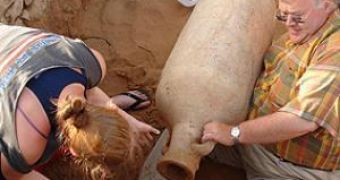Researchers from the University of British Columbia recently uncovered the remains of a woman and a child belonging to the rich class buried in a tomb under their house. Mixed elements of Christian and pagan burial rituals were also discovered at the site.
The remains were accidentally found by the locals almost half a century ago, when they were bulldozing the area near the Italian Punta Secca town, to the south east of the Sicilian Ragusa province, in order to clear the zone for new housing. Under the excavations, the ancient Roman village Kaukana was lying, consisting of 24 buildings, which a team of 15 archaeologists led by Professor Roger Wilson from the University of British Columbia's Department of Classical, Near Eastern and Religious Studies, studied thoroughly for the first time since 1972. The key finding of the research was the tomb placed in a room of a house dating from the 6th century AD, presenting features of both Christian and pagan burial rituals. What makes this discovery so odd is that generally, during that time, the bodies were earthed in cemeteries near the housing areas or surrounding a church, unlike this wealthy tomb.
According to Wilson, “It’s extremely unusual to find an elite burial set inside a house in the middle of a settlement, even as late as the sixth century”. Under the stony slab covering the tomb, the team found the skeletal remains of a woman aged 25-30 and of her child aged 5 to 7, whose sex could not be determined so far and whose body, as the scientists determined, was placed in the tomb later than the woman's. Her teeth were in perfect condition and no sign of arthritis was spotted. The tomb's slab was provided with a small hole that allowed for the pouring of libations which, as Wilson states, “shows that the long-established, originally pagan, rite of offering libations to the dead clearly continued into early Byzantine times”. Christian crosses were found to have been painted on a lamp nearby and on the inside of the slab, which, together with the fact that the bodies were wrapped in plaster (as it was customary for Christians of the time in order to prepare the body for its resurrection), indicate that the two persons were Christians. Proof of repeated feasting honoring the dead was found at the tomb's location, such as pots, glass and clay amphorae (found almost intact).
The team is anxious to resume the analysis of the site in order to shed more light on the rituals of the region at the time and to answer some questions still pending on the discovery. As Wilson shares, “Along with questions of when the house was built and whether it was still occupied when the tomb was inserted, we want to find out why the woman and child were buried in the tomb at all”.

 14 DAY TRIAL //
14 DAY TRIAL //